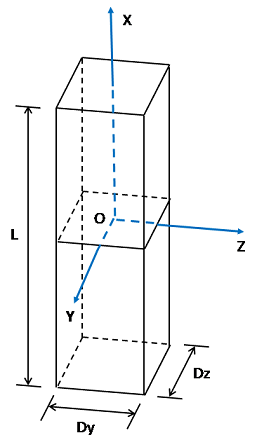The mass and moment of inertia of a circular cross section tube, with respect to the center of the element in the local tube axes, are
(6–23) |
where is the material density of the tube,
is the tube diameter,
is the tube wall thickness, and
is the length of the tube element.
The slender tube properties are defined in the principal centroidal axes, as shown in Figure 6.3: Slender Tube Definition. and
are the effective diameters normal to the y- and z-directions,
respectively.
The mass and moment of inertia of a slender tube with respect to the center of the element are
(6–24) |
where is the mass per unit length,
is the Y axis inertia per unit length, and
is the Z axis inertia per unit length.
(6–25) |
in which is the material density of the slender tube, and
is the structural cross sectional area.
There is neither hydrostatic force nor Froude-Krylov force acting on the circular disc element, as no disc thickness is taken into account. The added mass and drag force on one side of a completely submerged disc are given by
(6–26) |
where is the added mass coefficient for a double-sided disc (1.0 by default),
is the water density,
is the diameter of the circular disc,
is the drag coefficient for a double-sided disc (1.14 by default),
, and
is the relative normal velocity between the fluid particles and the
disc.
In Equation 6–26, the calculated forces are only
for the single side of the disc which is subject to the hydrodynamic pressure. If both sides are
subject to hydrodynamic pressure, taking into consideration that the pressure on one side is
positive and the pressure on the other side is negative, the input and
values should be doubled.



